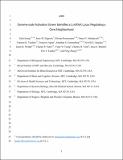| dc.contributor.author | Verdine, Vanessa K. | |
| dc.contributor.author | Aguet, Francois | |
| dc.contributor.author | Fulco, Charles P. | |
| dc.contributor.author | Tseng, Yuen-Yi | |
| dc.contributor.author | Boehm, Jesse S. | |
| dc.contributor.author | Joung, Julia | |
| dc.contributor.author | Engreitz, Jesse Michael | |
| dc.contributor.author | Konermann, Silvana M | |
| dc.contributor.author | Gootenberg, Jonathan S | |
| dc.contributor.author | Sanjana, Neville E | |
| dc.contributor.author | Wright, Jason | |
| dc.contributor.author | Yoon, Charles | |
| dc.contributor.author | Lander, Eric Steven | |
| dc.contributor.author | Zhang, Feng | |
| dc.contributor.author | Abudayyeh, Omar O. | |
| dc.date.accessioned | 2018-02-14T14:36:28Z | |
| dc.date.available | 2018-02-14T14:36:28Z | |
| dc.date.issued | 2017-08 | |
| dc.date.submitted | 2017-01 | |
| dc.identifier.issn | 0028-0836 | |
| dc.identifier.issn | 1476-4687 | |
| dc.identifier.uri | http://hdl.handle.net/1721.1/113649 | |
| dc.description.abstract | Mammalian genomes contain thousands of loci that transcribe long noncoding RNAs (lncRNAs), some of which are known to carry out critical roles in diverse cellular processes through a variety of mechanisms. Although some lncRNA loci encode RNAs that act non-locally (in trans), there is emerging evidence that many lncRNA loci act locally (in cis) to regulate the expression of nearby genes—for example, through functions of the lncRNA promoter, transcription, or transcript itself. Despite their potentially important roles, it remains challenging to identify functional lncRNA loci and distinguish among these and other mechanisms. Here, to address these challenges, we developed a genome-scale CRISPR–Cas9 activation screen that targets more than 10,000 lncRNA transcriptional start sites to identify noncoding loci that influence a phenotype of interest. We found 11 lncRNA loci that, upon recruitment of an activator, mediate resistance to BRAF inhibitors in human melanoma cells. Most candidate loci appear to regulate nearby genes. Detailed analysis of one candidate, termed EMICERI, revealed that its transcriptional activation resulted in dosage-dependent activation of four neighbouring protein-coding genes, one of which confers the resistance phenotype. Our screening and characterization approach provides a CRISPR toolkit with which to systematically discover the functions of noncoding loci and elucidate their diverse roles in gene regulation and cellular function. | en_US |
| dc.description.sponsorship | National Human Genome Research Institute (U.S.) (Grant R00-HG008171) | en_US |
| dc.description.sponsorship | National Institute of Diabetes and Digestive and Kidney Diseases (U.S.) (Grant F32-DK096822) | en_US |
| dc.description.sponsorship | National Institute of Mental Health (U.S.) (Grant 5DP1-MH100706) | en_US |
| dc.description.sponsorship | National Institute of Mental Health (U.S.) (Grant 1R01-MH110049) | en_US |
| dc.language.iso | en_US | |
| dc.publisher | Nature Publishing Group | en_US |
| dc.relation.isversionof | http://dx.doi.org/10.1038/nature23451 | en_US |
| dc.rights | Article is made available in accordance with the publisher's policy and may be subject to US copyright law. Please refer to the publisher's site for terms of use. | en_US |
| dc.source | Prof. Zhang via Courtney Crummett | en_US |
| dc.title | Genome-scale activation screen identifies a lncRNA locus regulating a gene neighbourhood | en_US |
| dc.type | Article | en_US |
| dc.identifier.citation | Joung, Julia et al. “Genome-Scale Activation Screen Identifies a lncRNA Locus Regulating a Gene Neighbourhood.” Nature 548, 7667 (August 2017): 343–346 | en_US |
| dc.contributor.department | Harvard University--MIT Division of Health Sciences and Technology | en_US |
| dc.contributor.department | Massachusetts Institute of Technology. Department of Biological Engineering | en_US |
| dc.contributor.department | Massachusetts Institute of Technology. Department of Biology | en_US |
| dc.contributor.department | Massachusetts Institute of Technology. Department of Brain and Cognitive Sciences | en_US |
| dc.contributor.department | McGovern Institute for Brain Research at MIT | en_US |
| dc.contributor.approver | Zhang, Feng | en_US |
| dc.contributor.mitauthor | Joung, Julia | |
| dc.contributor.mitauthor | Engreitz, Jesse Michael | |
| dc.contributor.mitauthor | Konermann, Silvana M | |
| dc.contributor.mitauthor | Abudayyeh, Omar Osama | |
| dc.contributor.mitauthor | Gootenberg, Jonathan S | |
| dc.contributor.mitauthor | Sanjana, Neville E | |
| dc.contributor.mitauthor | Wright, Jason | |
| dc.contributor.mitauthor | Yoon, Charles | |
| dc.contributor.mitauthor | Lander, Eric Steven | |
| dc.contributor.mitauthor | Zhang, Feng | |
| dc.relation.journal | Nature | en_US |
| dc.eprint.version | Author's final manuscript | en_US |
| dc.type.uri | http://purl.org/eprint/type/JournalArticle | en_US |
| eprint.status | http://purl.org/eprint/status/PeerReviewed | en_US |
| dspace.orderedauthors | Joung, Julia; Engreitz, Jesse M.; Konermann, Silvana; Abudayyeh, Omar O.; Verdine, Vanessa K.; Aguet, Francois; Gootenberg, Jonathan S.; Sanjana, Neville E.; Wright, Jason B.; Fulco, Charles P.; Tseng, Yuen-Yi; Yoon, Charles H.; Boehm, Jesse S.; Lander, Eric S.; Zhang, Feng | en_US |
| dspace.embargo.terms | N | en_US |
| dc.identifier.orcid | https://orcid.org/0000-0001-6656-5002 | |
| dc.identifier.orcid | https://orcid.org/0000-0002-5754-1719 | |
| dc.identifier.orcid | https://orcid.org/0000-0001-7915-1685 | |
| dc.identifier.orcid | https://orcid.org/0000-0002-7979-3220 | |
| dc.identifier.orcid | https://orcid.org/0000-0003-2782-2509 | |
| mit.license | PUBLISHER_POLICY | en_US |
